Bird R.B., Stewart W.E., Lightfoot E.N. Transport Phenomena
Подождите немного. Документ загружается.

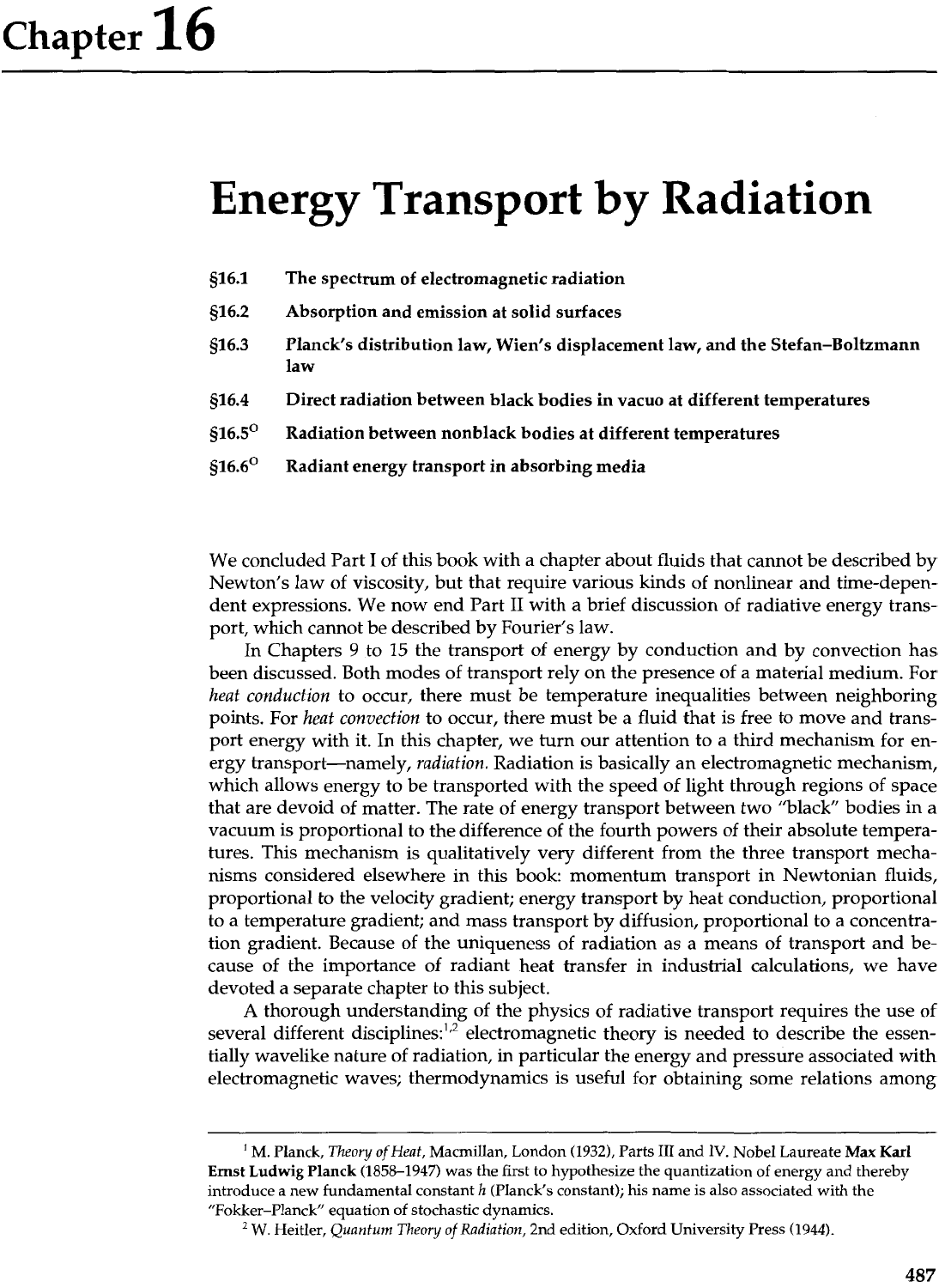
Chapter
16
Energy Transport
by
Radiation
516.1
The spectrum of electromagnetic radiation
916.2
Absorption and emission at solid surfaces
516.3
Planck's distribution law, Wien's displacement law, and the Stefan-Boltzmann
law
516.4
Direct radiation between black bodies in vacuo at different temperatures
516.5'
Radiation between nonblack bodies at different temperatures
516.6'
Radiant energy transport in absorbing media
We concluded Part
I
of this book with a chapter about fluids that cannot be described by
Newton's law of viscosity, but that require various kinds of nonlinear and time-depen-
dent expressions. We now end Part I1 with a brief discussion of radiative energy trans-
port, which cannot be described by Fourier's law.
In Chapters
9
to
15
the transport of energy by conduction and by convection has
been discussed. Both modes of transport rely on the presence of a material medium. For
heat conduction
to occur, there must be temperature inequalities between neighboring
points. For
heat convection
to occur, there must be a fluid that is free to move and trans-
port energy with it. In this chapter, we turn our attention to a third mechanism for en-
ergy transport-namely,
radiation.
Radiation is basically an electromagnetic mechanism,
which allows energy to be transported with the speed of light through regions of space
that are devoid of matter. The rate of energy transport between two "black bodies in a
vacuum
is
proportional to the difference of the fourth powers of their absolute tempera-
tures. This mechanism is qualitatively very different from the three transport mecha-
nisms considered elsewhere in this book: momentum transport in Newtonian fluids,
proportional to the velocity gradient; energy transport by heat conduction, proportional
to a temperature gradient; and mass transport by diffusion, proportional to a concentra-
tion gradient. Because of the uniqueness of radiation as a means of transport and be-
cause of the importance of radiant heat transfer in industrial calculations, we have
devoted a separate chapter to this subject.
A
thorough understanding of the physics of radiative transport requires the use of
several different
discipline^:',^
electromagnetic theory is needed to describe the essen-
tially wavelike nature of radiation, in particular the energy and pressure associated with
electromagnetic waves; thermodynamics is useful for obtaining some relations among
M.
Planck,
Theory ofHeat,
Macmillan, London (1932), Parts
111
and
IV.
Nobel Laureate
Max
Karl
Ernst
Ludwig
Planck (1858-1947) was the first to hypothesize the quantization of energy and thereby
introduce
a
new fundamental constant
h
(Planck's constant); his name is also associated with the
"Fokker-Planck" equation of stochastic dynamics.
W.
Heitler,
Quantum
Theory
of
Radiation,
2nd edition, Oxford University Press (1944).
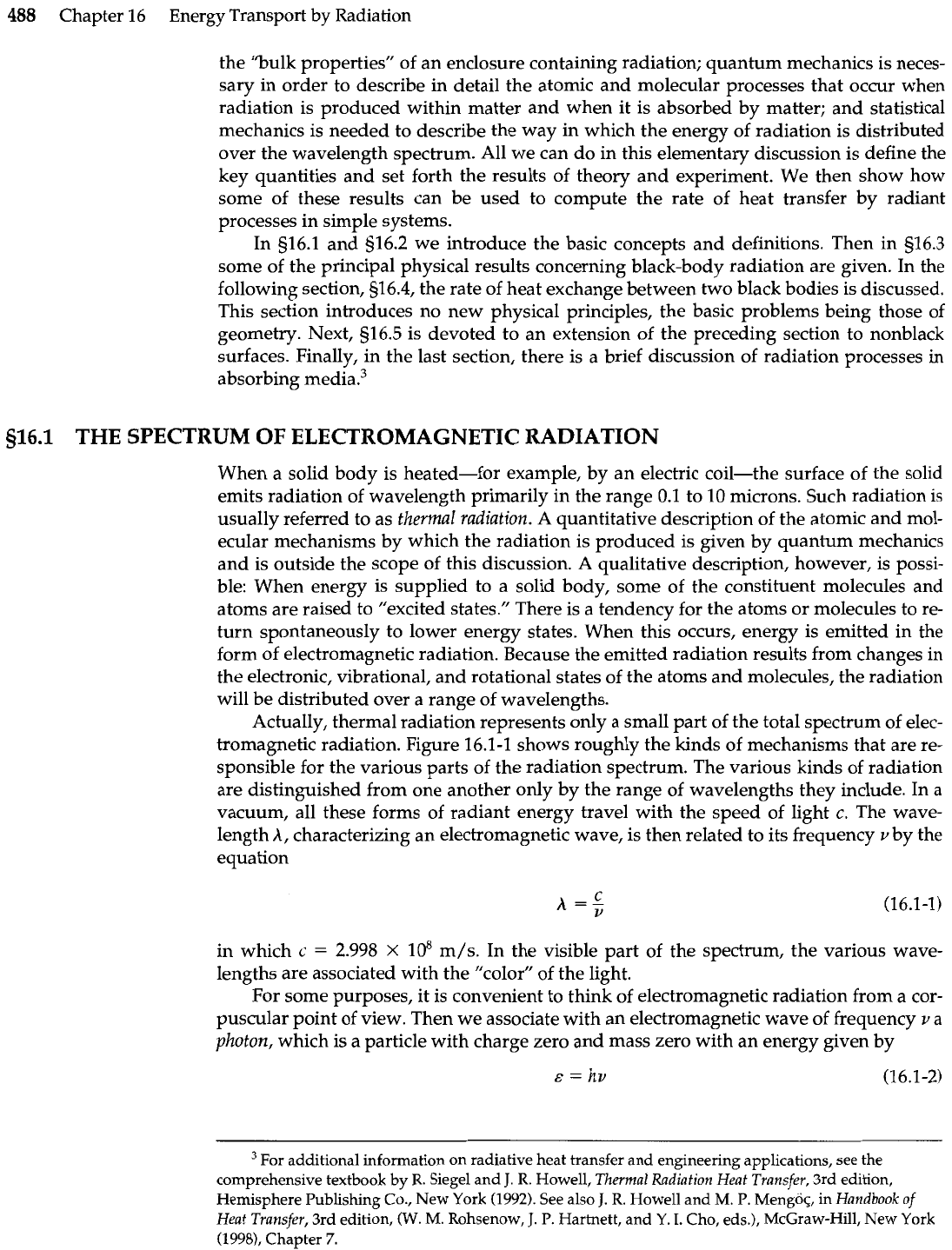
488
Chapter
16
Energy Transport
by
Radiation
the "bulk properties" of an enclosure containing radiation; quantum mechanics is neces-
sary in order to describe in detail the atomic and molecular processes that occur when
radiation is produced within matter and when it is absorbed by matter; and statistical
mechanics is needed to describe the way in which the energy of radiation is distributed
over the wavelength spectrum. All we can do in this elementary discussion is define the
key quantities and set forth the results of theory and experiment. We then show how
some of these results can be used to compute the rate of heat transfer by radiant
processes in simple systems.
In $16.1 and $16.2 we introduce the basic concepts and definitions. Then in s16.3
some of the principal physical results concerning black-body radiation are given. In the
following section, $16.4, the rate of heat exchange between two black bodies is discussed.
This section introduces no new physical principles, the basic problems being those of
geometry. Next, 516.5 is devoted to an extension of the preceding section to nonblack
surfaces. Finally, in the last section, there is a brief discussion of radiation processes
in
absorbing media.3
516.1
THE SPECTRUM OF ELECTROMAGNETIC RADIATION
When a solid body is heated-for example, by an electric coil-the surface of the solid
emits radiation of wavelength primarily in the range 0.1 to
10
microns. Such radiation
is
usually referred to as thermal radiation. A quantitative description of the atomic and mol-
ecular mechanisms by which the radiation is produced is given by quantum mechanics
and is outside the scope of this discussion. A qualitative description, however, is possi-
ble: When energy is supplied to a solid body, some of the constituent molecules and
atoms are raised to "excited states." There is a tendency for the atoms or molecules to re-
turn spontaneously to lower energy states. When this occurs, energy is emitted in the
form of electromagnetic radiation. Because the emitted radiation results from changes in
the electronic, vibrational, and rotational states of the atoms and molecules, the radiation
will be distributed over a range of wavelengths.
Actually, thermal radiation represents only a small part of the total spectrum of elec-
tromagnetic radiation. Figure 16.1-1 shows roughly the kinds of mechanisms that are re-
sponsible for the various parts of the radiation spectrum. The various kinds of radiation
are distinguished from one another only by the range of wavelengths they include. In
a
vacuum, all these forms of radiant energy travel with the speed of light
c.
The wave-
length
A,
characterizing an electromagnetic wave, is then related to its frequency
v
by the
equation
in which
c
=
2.998
x
lo8
m/s. In the visible part of the spectrum, the various wave-
lengths are associated with the "color" of the light.
For some purposes, it is convenient to think of electromagnetic radiation from a cor-
puscular point of view. Then we associate with an electromagnetic wave of frequency
v
a
photon, which is a particle with charge zero and mass zero with an energy given by
For additional information on radiative heat transfer and engineering applications, see the
comprehensive textbook by R. Siege1 and
J.
R. Howell,
Thermal Radiation Heat Transfer,
3rd edition,
Hemisphere Publishing Co., New York (1992). See also
J.
R.
Howell and
M.
P.
Mengoq, in
Handbook of
Heat Transfer,
3rd edition,
(W.
M.
Rohsenow,
J.
P.
Hartnett, and
Y.
I.
Cho, eds.), McGraw-Hill, New York
(1998), Chapter
7.
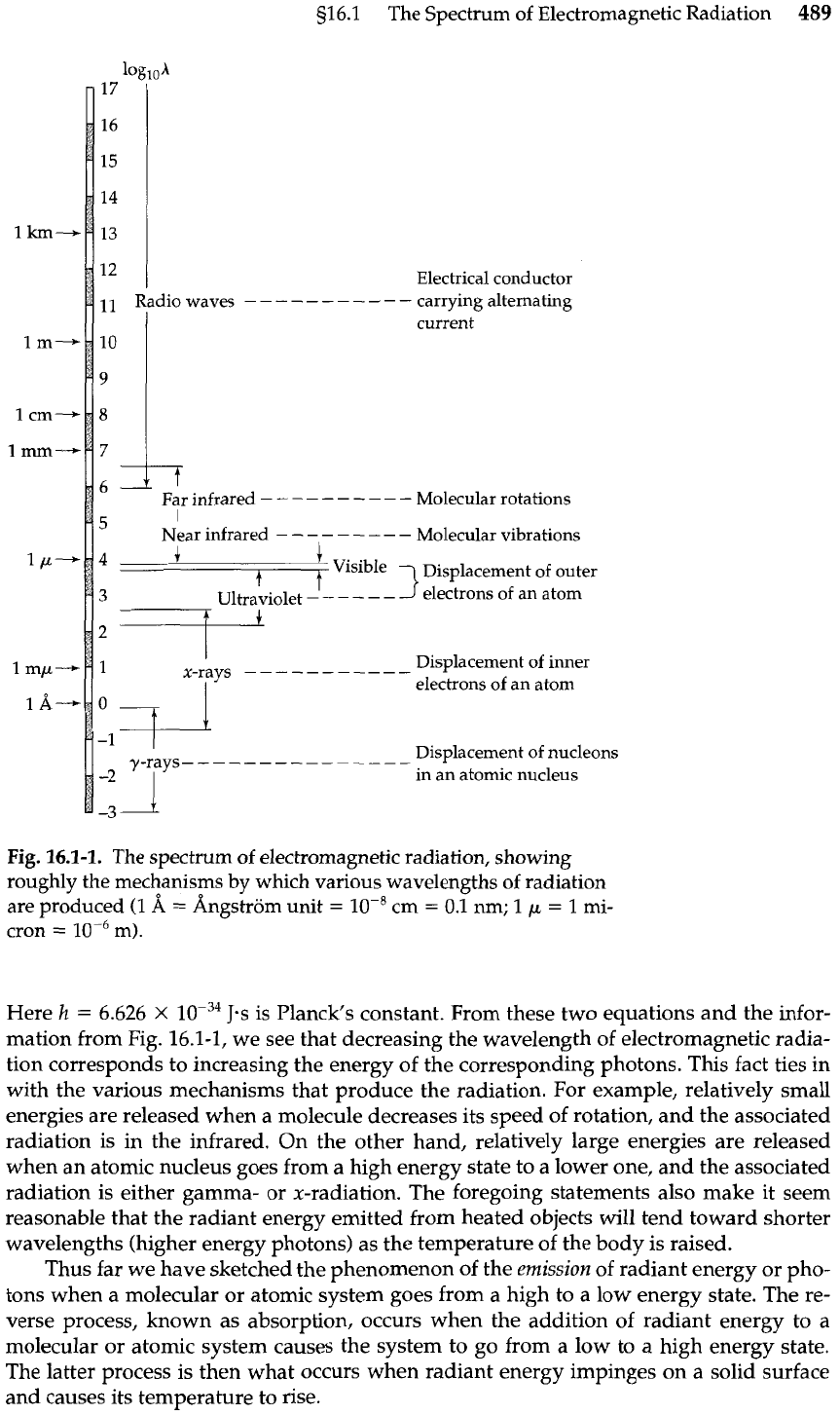
916.1 The Spectrum of Electromagnetic Radiation
489
Electrical conductor
11
Radio waves
- -
-
-
- -
-
-
- - -
carrying alternating
8"
current
-
-
-
-
Molecular rotations
Near infrared
-
-
-
-
-
- - - -
Molecular vibrations
~ibk
3
Displacement of outer
iolet
- -
-
-
- -
electrons of an atom
Displacement of inner
electrons of an atom
Displacement of nucleons
in an atomic nucleus
Fig.
16.1-1.
The spectrum of electromagnetic radiation, showing
roughly the mechanisms by which various wavelengths of radiation
are produced (1
A
=
Angstrom unit
=
lo-'
cm
=
0.1 nm;
1
p
=
1 mi-
cron
=
l~-~
m).
Here
h
=
6.626
X
J,s is Planck's constant. From these two equations and the infor-
mation from Fig. 16.1-1, we see that decreasing the wavelength of electromagnetic radia-
tion corresponds to increasing the energy of the corresponding photons. This fact ties in
with the various mechanisms that produce the radiation. For example, relatively small
energies are released when a molecule decreases its speed of rotation, and the associated
radiation is in the infrared. On the other hand, relatively large energies are released
when an atomic nucleus goes from a high energy state to a lower one, and the associated
radiation is either gamma- or x-radiation. The foregoing statements also make it seem
reasonable that the radiant energy emitted from heated objects will tend toward shorter
wavelengths (higher energy photons) as the temperature of the body is raised.
Thus far we have sketched the phenomenon of the
emission
of radiant energy or pho-
tons when
a
molecular or atomic system goes from a high to a low energy state. The re-
verse process, known as absorption, occurs when the addition of radiant energy to a
molecular or atomic system causes the system to go from a low to a high energy state.
The latter process is then what occurs when radiant energy impinges on a solid surface
and causes its temperature to rise.

490
Chapter
16
Energy Transport
by
Radiation
516.2
ABSORPTION AND EMISSION AT SOLID SURFACES
Having introduced the concepts of absorption and emission in terms of the atomic pic-
ture, we now proceed to the discussion of the same processes from
a
macroscopic view-
point. We restrict the discussion here to opaque solids.
Radiation impinging on the surface of an opaque solid is either absorbed or re-
flected. The fraction of the incident radiation that is absorbed is called the
absorptivity
and is given the symbol
a.
Also the fraction of the incident radiation with frequency
v
that is absorbed is designated by
a,.
That is,
a
and
a,
are defined as
in which
qt'dv
and
q!'dv
are the absorbed and incident radiation per unit area per unit
time in the frequency range
v
to
v
+
dv.
For any
real body,
a,
will be less than unity and
will vary considerably with the frequency. A hypothetical body for which
a,
is a con-
stant, less than unity, over the entire frequency range and at all temperatures is called
a
gray body.
That is, a gray body always absorbs the same fraction of the incident radiation
of all frequencies.
A
limiting case of the gray body is that for which
a,
=
1 for all frequen-
cies and all temperatures. This limiting behavior defines a
black body.
All solid surfaces emit radiant energy. The total radiant energy emitted per unit area
per unit time is designated by
q'",
and that emitted in the frequency range
u
to
u
+
dv
is
called
qf'dv.
The corresponding rates of energy emission from a black body are given the
symbols
qjf)
and
qlP,'du.
In terms of these quantities, the
emissivity
for the total radiant-en-
ergy emission as well as that for a given frequency are defined as
The emissivity is also a quantity less than unity for real, nonfluorescing surfaces and is
equal to unity for black bodies. At any given temperature the radiant energy emitted by
a black body represents an upper limit to the radiant energy emitted by real, nonfluo-
rescing surfaces.
We now consider the radiation within an evacuated enclosure or "cavity" with
isothermal walls. We imagine that the entire system is at equilibrium. Under this condi-
tion, there is no net flux of energy across the interfaces between the solid and the cavity.
We now show that the radiation in such a cavity is independent of the nature of the
walls and dependent solely on the temperature of the walls of the cavity. We connect
two cavities, the walls of which are at the same temperature, but are made of two differ-
ent materials, as shown in Fig. 16.2-1. If the radiation intensities in the two cavities were
different, there would be a net transport of radiant energy from one cavity to the other.
Because such a flux would violate the second law of thermodynamics, the radiation in-
tensities in the two cavities must be equal, regardless of the compositions of the cavity
surfaces. Furthermore, it can be shown that the radiation is uniform and unpolarized
throughout the cavity. This
cavity radiation
plays an important role in the development
Material
1
Material
2
Fig.
16.2-1.
Thought experiment for proof that cavity radi-
ation is independent of the wall materials.
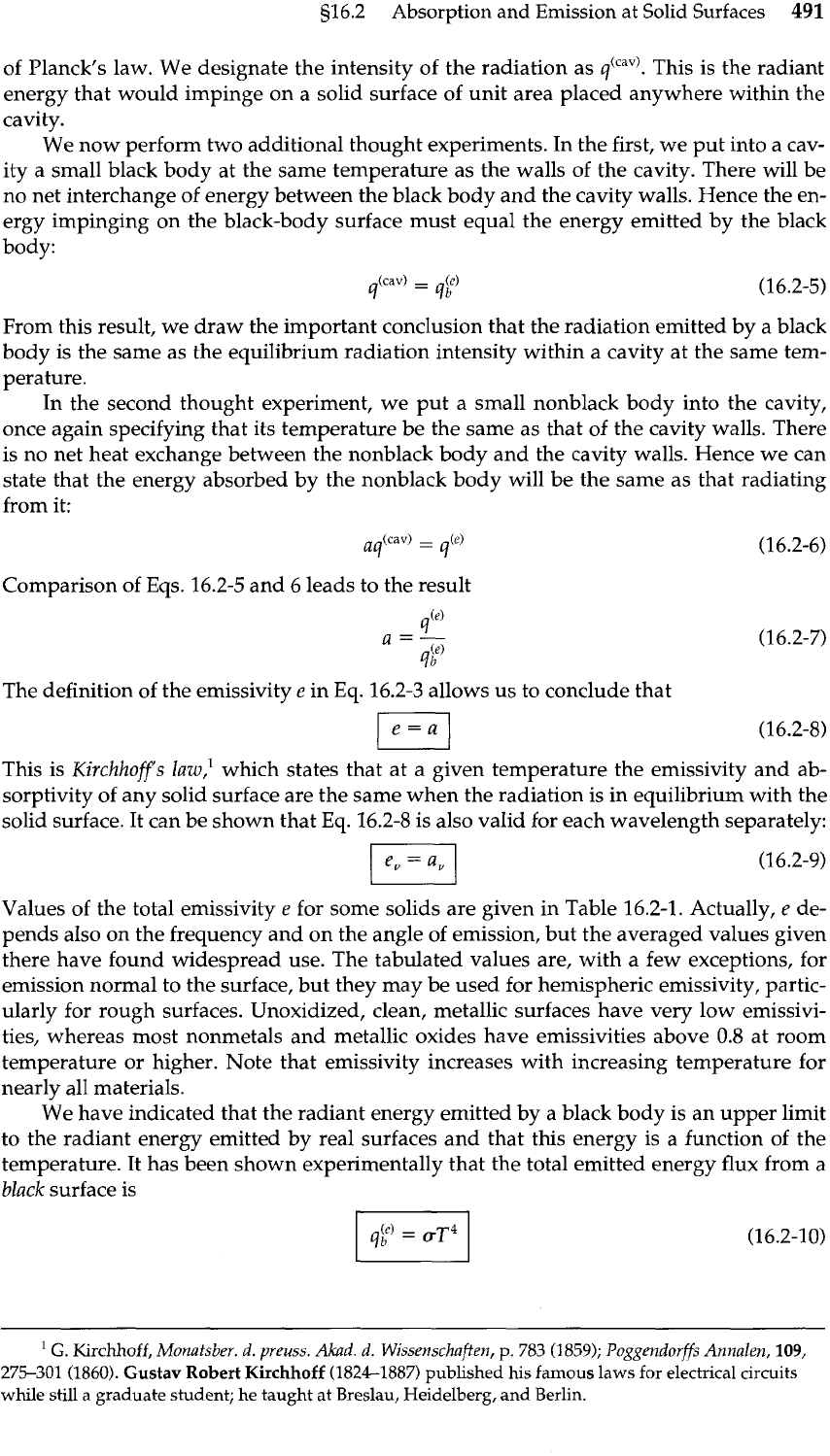
916.2
Absorption and Emission at Solid Surfaces
491
of Planck's law. We designate the intensity of the radiation as
q""").
This is the radiant
energy that would impinge on a solid surface of unit area placed anywhere within the
cavity.
We now perform two additional thought experiments. In the first, we put into a cav-
ity a small black body at the same temperature as the walls of the cavity. There will be
no net interchange of energy between the black body and the cavity walls. Hence the en-
ergy impinging on the black-body surface must equal the energy emitted by the black
body:
From this result, we draw the important conclusion that the radiation emitted by a black
body is the same as the equilibrium radiation intensity within a cavity at the same tem-
perature.
In the second thought experiment, we put a small nonblack body into the cavity,
once again specifying that its temperature be the same as that of the cavity walls. There
is no net heat exchange between the nonblack body and the cavity walls. Hence we can
state that the energy absorbed by the nonblack body will be the same as that radiating
from it:
Comparison of Eqs. 16.2-5 and
6
leads to the result
The definition of the emissivity
e
in Eq. 16.2-3 allows us to conclude that
PI
(16.2-8)
This is
Kirchhoff's
law,' which states that at a given temperature the emissivity and ab-
sorptivity of any solid surface are the same when the radiation is in equilibrium with the
solid surface. It can be shown that Eq. 16.2-8 is also valid for each wavelength separately:
(16.2-9)
Values of the total emissivity
e
for some solids are given in Table 16.2-1. Actually,
e
de-
pends also on the frequency and on the angle of emission, but the averaged values given
there have found widespread use. The tabulated values are, with a few exceptions, for
emission normal to the surface, but they may be used for hemispheric emissivity, partic-
ularly for rough surfaces. Unoxidized, clean, metallic surfaces have very low emissivi-
ties, whereas most nonmetals and metallic oxides have emissivities above 0.8 at room
temperature or higher. Note that emissivity increases with increasing temperature for
nearly all materials.
We have indicated that the radiant energy emitted by a black body is an upper limit
to the radiant energy emitted by real surfaces and that this energy is a function of the
temperature. It has been shown experimentally that the total emitted energy flux from a
black surface is
-
-
-
G.
Kirchhoff,
Monatsbeu. d. preuss. Akad.
d.
Wissenschaften,
p.
783 (1859);
Poggendorffs Annalen,
109,
275-301 (1860).
Gustav Robert
Kirchhoff
(1824-1887)
published
his
famous laws
for
electrical circuits
while still
a
graduate student; he taught at Breslau, Heidelberg, and Berlin.
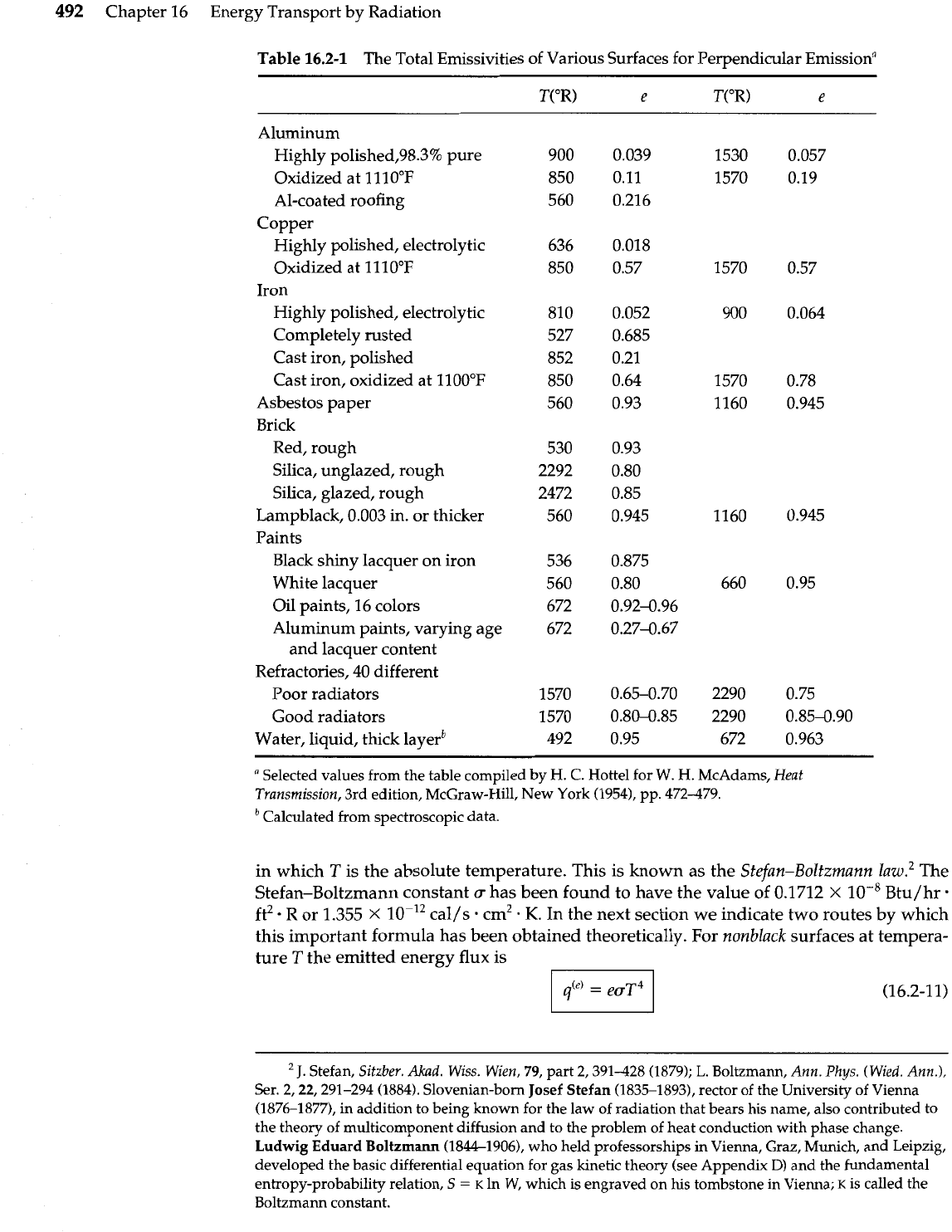
492
Chapter 16 Energy Transport by Radiation
Table
16.2-1
The Total Emissivities of Various Surfaces for Perpendicular Emissiona
Aluminum
Highly polished,98.3% pure
Oxidized at 1110°F
Al-coated roofing
Copper
Highly polished, electrolytic
Oxidized at 11 10°F
Iron
Highly polished, electrolytic
Completely rusted
Cast iron, polished
Cast iron, oxidized at llOO°F
Asbestos paper
Brick
Red, rough
Silica, unglazed, rough
Silica, glazed, rough
Lampblack, 0.003 in. or thicker
Paints
Black shiny lacquer on iron
White lacquer
Oil paints, 16 colors
Aluminum paints, varying age
and lacquer content
Refractories, 40 different
Poor radiators
Good radiators
Water, liquid, thick layerb
"elected values from the table compiled by
H.
C. Hottel for
W.
H.
McAdams, Heat
Transmission, 3rd edition, McGraw-Hill, New York (1954), pp. 472479.
Calculated from spectroscopic data.
in which
T
is the absolute temperature. This is known as the Stefan-Boltzmann
law.'
The
Stefan-Boltzmann constant u has been found to have the value of 0.1712
X
Btu/hr
ft2
R
or 1.355
X
10-l2 cal/s cm2
.
K.
In the next section we indicate two routes by which
this important formula has been obtained theoretically. For nonblack surfaces at tempera-
ture
T
the emitted energy flux is
q(e)
=
euT4
1
(16.2-1
1)
J.
Stefan, Sitzber. Akad. Wiss. Wien,
79,
part 2,391428 (1879); L. Boltzmann, Ann.
Phys.
(Wied. Ann.),
Ser. 2,22,291-294 (1884). Slovenian-born Josef Stefan (1835-1893), rector of the University of Vienna
(1876-1877), in addition to being known for the law of radiation that bears his name, also contributed to
the theory of multicomponent diffusion and to the problem of heat conduction with phase change.
Ludwig Eduard Boltzmann (1844-1906), who held professorships in Vienna, Graz, Munich, and Leipzig,
developed the basic differential equation for gas kinetic theory (see Appendix
D)
and the fundamental
entropy-probability relation,
S
=
K
In
W,
which is engraved
on
his tombstone in Vienna;
K
is called the
Boltzmann constant.
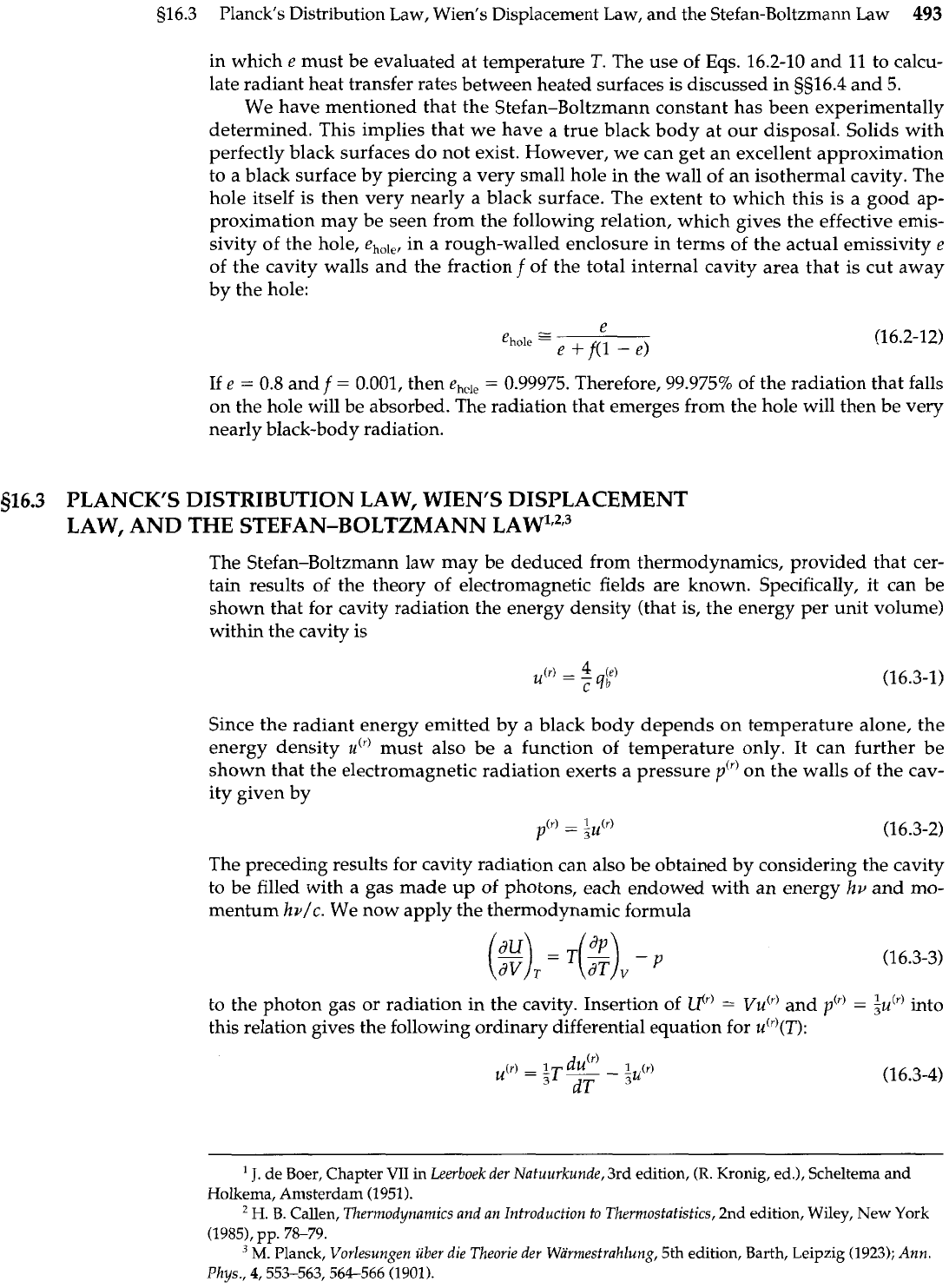
316.3
Planck's Distribution Law, Wien's Displacement Law, and the Stefan-Boltzmann Law
493
in which
e
must be evaluated at temperature
T.
The use of Eqs. 16.2-10 and 11 to calcu-
late radiant heat transfer rates between heated surfaces is discussed in g516.4 and
5.
We have mentioned that the Stefan-Boltzmann constant has been experimentally
determined. This implies that we have a true black body at our disposal. Solids with
perfectly black surfaces do not exist. However, we can get an excellent approximation
to a black surface by piercing a very small hole in the wall of an isothermal cavity. The
hole itself is then very nearly a black surface. The extent to which this is a good
ap-
proximation may be seen from the following relation, which gives the effective emis-
sivity of the hole, eh,,,, in a rough-walled enclosure in terms of the actual emissivity e
of the cavity walls and the fraction
f
of the total internal cavity area that is cut away
by the hole:
If e
=
0.8 and
f
=
0.001, then e,,,,
=
0.99975.
Therefore,
99.975%
of the radiation that falls
on the hole will be absorbed. The radiation that emerges from the hole will then be very
nearly black-body radiation.
516.3
PLANCK'S DISTRIBUTION LAW, WIEN'S DISPLACEMENT
LAW, AND THE STEFAN-BOLTZMANN LAW1r2r3
The Stefan-Boltzmann law may be deduced from thermodynamics, provided that cer-
tain results of the theory of electromagnetic fields are known. Specifically, it can be
shown that for cavity radiation the energy density (that is, the energy per unit volume)
within the cavity is
Since the radiant energy emitted by a black body depends on temperature alone, the
energy density u"' must also be
a
function of temperature only. It can further be
shown that the electromagnetic radiation exerts a pressure
p(')
on the walls of the cav-
ity given by
(r)
-
Z
(7)
P
-3u
(16.3-2)
The preceding results for cavity radiation can also be obtained by considering the cavity
to be filled with a gas made up of photons, each endowed with an energy
hv
and mo-
mentum
hv/c.
We now apply the thermodynamic formula
to the photon gas or radiation in the cavity. Insertion of
U'"
=
Vu'" and p'"
=
$u"' into
this relation gives the following ordinary differential equation for u(')(T):
'
J.
de Boer, Chapter
VII
in
Leerboek der Nafuurkunde,
3rd
edition,
(R.
Kronig, ed.), Scheltema and
Holkema, Amsterdam (1951).
H.
B.
Callen,
Thermodynamics and an Introduction to Thermostatistics,
2nd edition, Wiley,
New
York
(1985),
pp.
78-79.
"
M.
Planck,
Vorlesungen uber die Theorie der Wiirmestmhlung,
5th edition, Barth, Leipzig (1923);
Ann.
Phys.,
4,553-563,564-566 (1901).
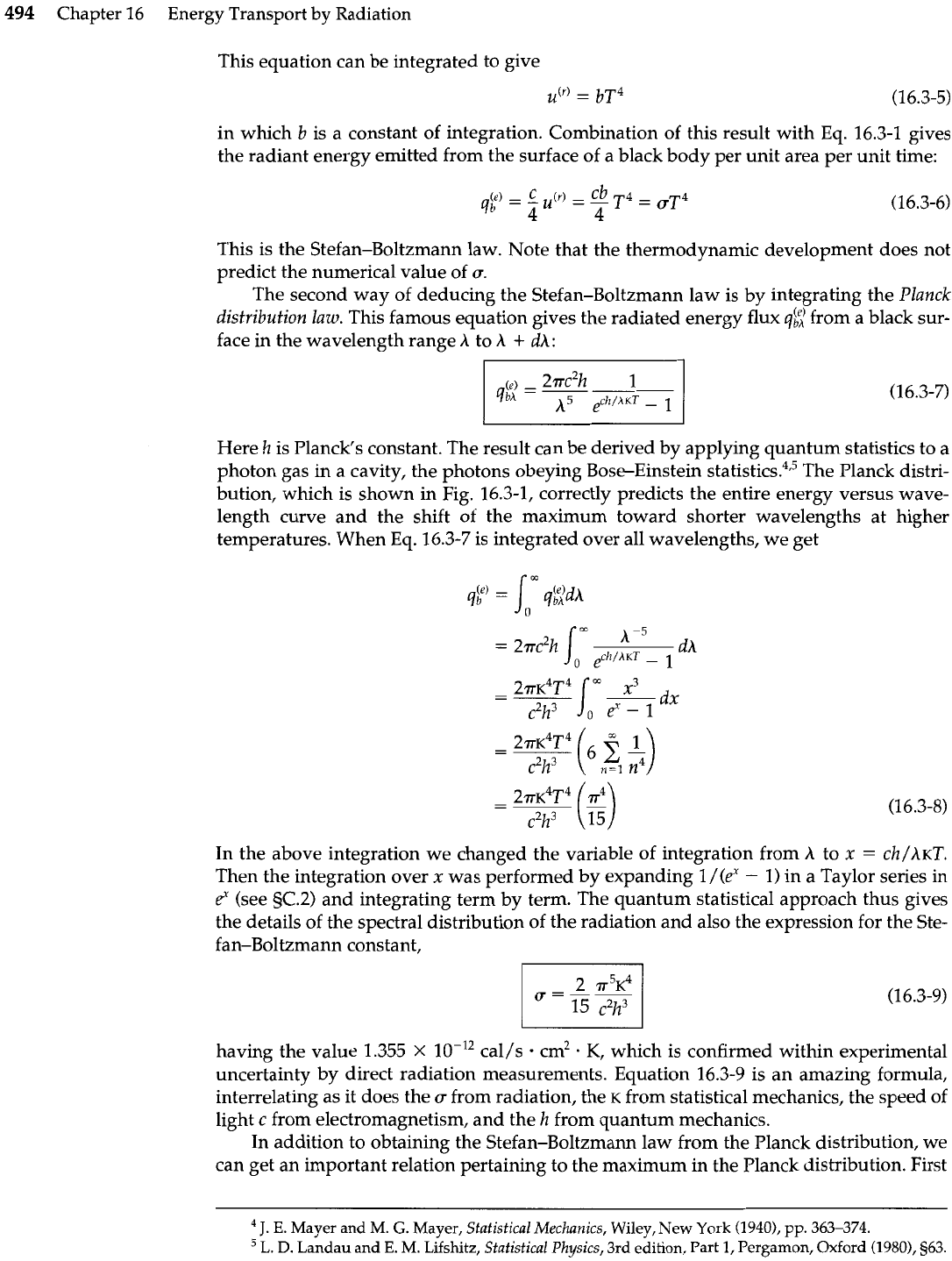
494
Chapter
16
Energy Transport by Radiation
This equation can be integrated to give
in which
b
is a constant of integration. Combination of this result with Eq. 16.3-1 gives
the radiant energy emitted from the surface of a black body per unit area per unit time:
This is the Stefan-Boltzmann law. Note that the thermodynamic development does not
predict the numerical value of
a.
The second way of deducing the Stefan-Boltzmann law is by integrating the
Planck
distribution
law.
This famous equation gives the radiated energy flux
qg
from a black sur-
face in the wavelength range
A
to
A
+
dA:
Here
h
is Planck's constant. The result can be derived by applying quantum statistics to a
photon gas
in
a cavity, the photons obeying Bose-Einstein
statistic^.^,'
The Planck distri-
bution, which is shown in Fig. 16.3-1, correctly predicts the entire energy versus wave-
length curve and the shift of the maximum toward shorter wavelengths at higher
temperatures. When Eq. 16.3-7 is integrated over all wavelengths, we get
In the above integration we changed the variable of integration from
A
to
x
=
ch/h~T.
Then the integration over
x
was performed by expanding l/(ex
-
1)
in a Taylor series in
8
(see
5C.2)
and integrating term by term. The quantum statistical approach thus gives
the details of the spectral distribution of the radiation and also the expression for the Ste-
fan-Boltzmann constant,
-
having the value 1.355
X
lo-''
cal/s cm2
.
K,
which is confirmed within experimental
uncertainty by direct radiation measurements. Equation 16.3-9 is an amazing formula,
interrelating as it does the
a
from radiation, the
K
from statistical mechanics, the speed of
light c from electromagnetism, and the
h
from quantum mechanics.
In addition to obtaining the Stefan-Boltzmann law from the Planck distribution, we
can get an important relation pertaining to the maximum in the Planck distribution. First
-
J.
E.
Mayer and M.
G.
Mayer,
Statistical
Mechanics,
Wiley, New York (1940),
pp.
363-374.
'
L.
D.
Landau and
E.
M. Lifshitz,
Statistical
Physics,
3rd edition, Part
1,
Pergamon, Oxford
(1980),
§63.
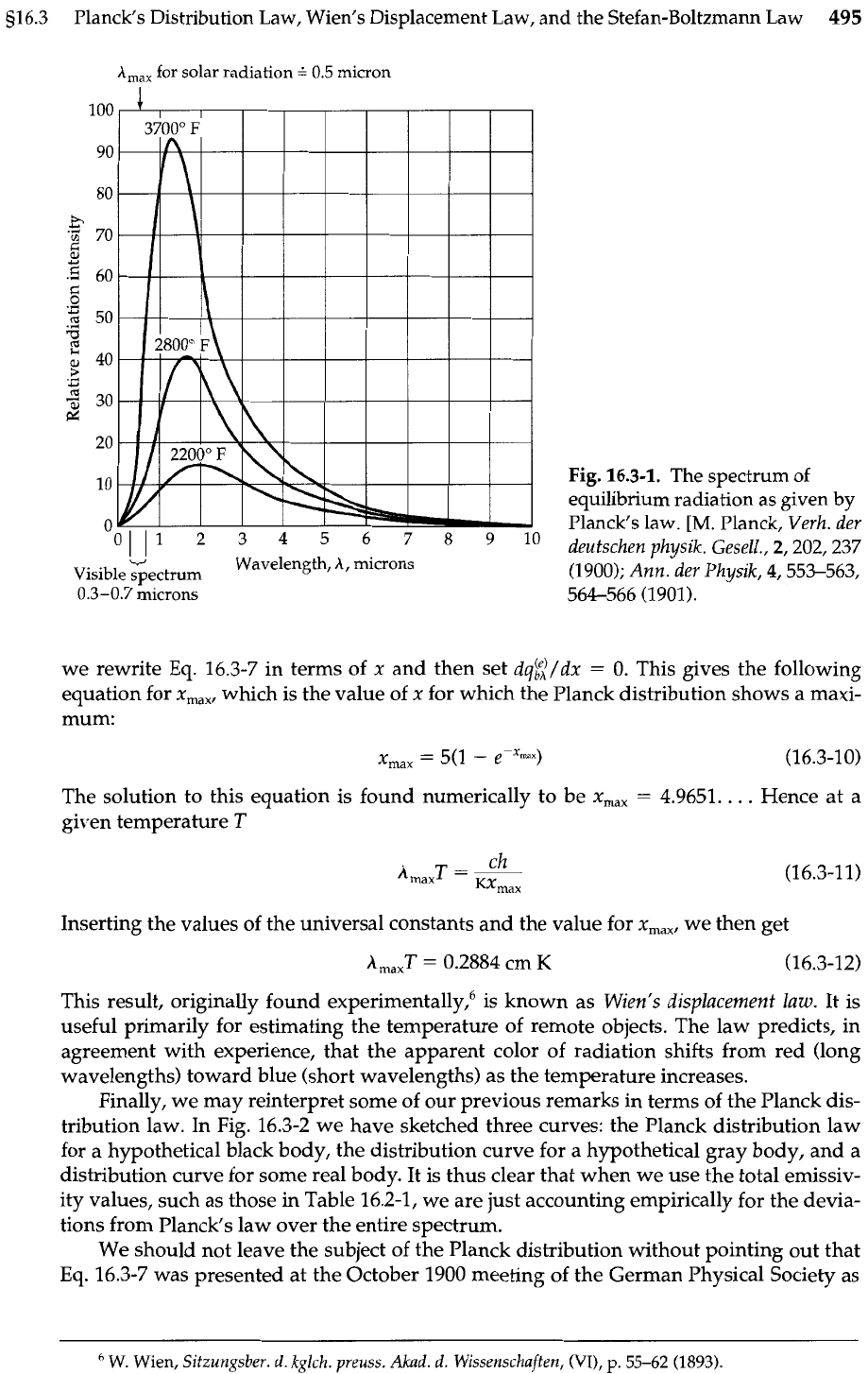
516.3
Planck's Distribution Law, Wien's Displacement Law, and the Stefan-Boltzmann Law
495
A,,,
for solar radiation
0.5 micron
8,
v
Wavelength,
A,
microns
Visible spectrum
0.3-0.7 microns
Fig.
16.3-1.
The spectrum of
equilibrium radiation as given
by
Planck's law.
[M.
Planck,
Veuh. der
deutschen ahusik. Gesell., 2,202,237
we rewrite Eq. 16.3-7 in terms of x and then set dqg/dx
=
0.
This gives the following
equation for x,,,, which is the value of x for which the Planck distribution shows a maxi-
mum:
The solution to this equation is found numerically to be x,,
=
4.9651.
. . .
Hence at a
given temperature
T
Inserting the values of the universal constants and the value for x,,,, we then get
This result, originally found experimentally,6 is known as Wien's displacement law. It is
useful primarily for estimating the temperature of remote objects. The law predicts, in
agreement with experience, that the apparent color of radiation shifts from red (long
wavelengths) toward blue (short wavelengths) as the temperature increases.
Finally, we may reinterpret some of our previous remarks in terms of the Planck dis-
tribution law. In Fig. 16.3-2 we have sketched three curves: the Planck distribution law
for a hypothetical black body, the distribution curve for a hypothetical gray body, and a
distribution curve for some real body. It is thus clear that when we use the total ernissiv-
ity values, such as those in Table 16.2-1, we are just accounting empirically for the devia-
tions from Planck's law over the entire spectrum.
We should not leave the subject of the Planck distribution without pointing out that
Eq.
16.3-7 was presented at the October 1900 meeting of the German Physical Society as
W. Wien,
Sitzungsber.
d.
kglch. preuss.
Akad.
d.
Wissenschaften,
(VI),
p.
55-62
(1893).
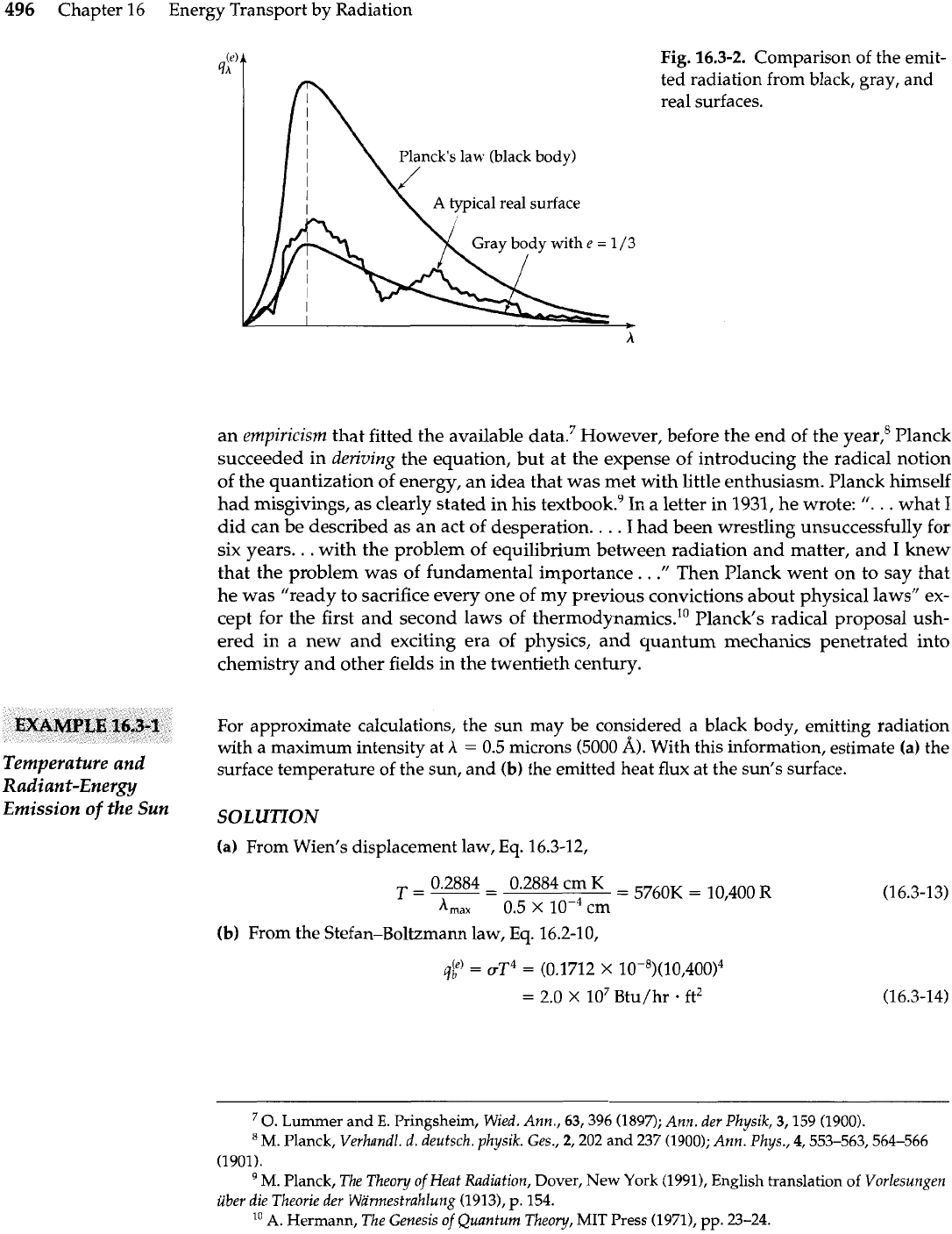
496
Chapter 16 Energy Transport by Radiation
Planck's law (black body)
Fig.
16.3-2.
Comparison of the emit-
ted radiation from black, gray, and
real surfaces.
an
empiricism
that fitted the available data.7 However, before the end of the year,' Planck
succeeded in
deriving
the equation, but at the expense of introducing the radical notion
of the quantization of energy, an idea that was met with little enthusiasm. Planck himself
had misgivings, as clearly stated in his textbook.'
In
a letter in 1931, he wrote:
".
. .
what
I
did can be described as an act of desperation.
. .
.
I
had been wrestling unsuccessfully for
six years.
. .
with the problem of equilibrium between radiation and matter, and
I
knew
that the problem was of fundamental importance.
.
."
Then Planck went on to say that
he was "ready to sacrifice every one of my previous convictions about physical laws" ex-
cept for the first and second laws of
thermodynamic^.'^
Planck's radical proposal ush-
ered in a new and exciting era of physics, and quantum mechanics penetrated into
chemistry and other fields in the twentieth century.
EXAMPLE
16.3-1
Temperature and
For approximate calculations, the sun may be considered a black body, emitting radiation
with a maximum intensity at
h
=
0.5 microns (5000
A).
With this information, estimate
(a)
the
surface temperature of the sun, and
(b)
the emitted heat flux at the sun's surface.
Radian t-Energy
Emission of the Sun SOLUTION
(a)
From Wien's displacement law, Eq. 16.3-12,
(b)
From the Stefan-Boltzmann law, Eq. 16.2-10,
0.
Lummer and
E.
Pringsheim,
Wied. Ann.,
63,396 (1897);
Ann. der Physik,
3,159 (1900).
M.
Planck,
Verhandl.
d,
deutsch. physik. Ges.,
2,202
and
237 (1900);
Ann. Phys.,
4,553-563,564-566
(1901).
M.
Planck,
The Theory of Heat Radiation,
Dover, New
York
(1991),
English translation of
Vorlesungen
uber die Theorie der Warmestrahlung
(1913),
p.
154.
lo
A.
Hermann,
The Genesis of Quantum Theory,
MIT
Press
(1971),
pp.
23-24.
